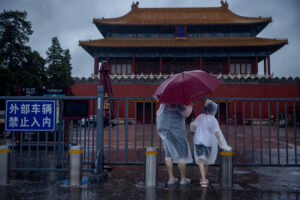
China vows to ‘transform’ economic model, targets growth at around 5%
BEIJING – China will target economic growth of around 5% this year as it works to transform its development model, curb industrial overcapacity, defuse property sector risks and cut wasteful spending by local governments, Premier Li Qiang said on Tuesday.
Li delivered his maiden work report at the annual meeting of the National People’s Congress (NPC), China’s rubber-stamp legislature, in the cavernous Great Hall of the People in Tiananmen Square.
The growth target was similar to last year’s but will require stronger government stimulus for China to reach it, as the economy remains reliant on state investments in infrastructure that have led to a mountain of municipal debt.
A stuttering post-COVID recovery in the past year has laid bare China’s deep structural imbalances, from weak household consumption to increasingly lower returns on investment, prompting calls for a new development model.
A property crisis, deepening deflation, a stock market rout, and mounting local government debt woes have increased the pressure on China’s leaders to respond to these calls.
“We should not lose sight of worst-case scenarios and should be well prepared for all risks and challenges,” Li said.
“In particular, we must push ahead with transforming the growth model, making structural adjustments, improving quality, and enhancing performance.”
There were no immediate details on the changes China intended to implement.
In setting the growth target, policymakers “have taken into account the need to boost employment and incomes and prevent and defuse risks,” Li said, adding China intended to have a “proactive” fiscal stance and “prudent” monetary policy.
China plans to run a budget deficit of 3% of economic output, down from a revised 3.8% last year. But crucially, it plans to issue 1 trillion yuan ($139 billion) in special ultra-long term treasury bonds, which are not included in the budget.
The special bond issuance quota for local governments was set at 3.9 trillion yuan, versus 3.8 trillion yuan in 2023. China also set the consumer inflation target at 3% and aims to create over 12 million urban jobs this year, keeping the jobless rate at around 5.5%.
“The Chinese government does not want to stimulate the economy too much, … and also wants to keep leverage relatively low,” said Xia Qingjie, economics professor at Peking University. The budget deficit target can be adjusted later this year, if needed, Xia added.
Analysts expect China to lower its annual growth ambitions in the future. The International Monetary Fund projects China’s economic growth at 4.6% this year, declining further in the medium term to about 3.5% in 2028.
‘NEW PRODUCTIVE FORCES’
China will continue to pour resources into tech innovation and advanced manufacturing, in line with President Xi Jinping’s push for “new productive forces,” Li said.
Some analysts have criticized this policy, however, saying it exacerbates industrial overcapacity, deepens deflation and heightens trade tensions with the West.
Reform advocates, worried about record low consumer confidence and plunging investor and business sentiment, want China to return to a path of pro-market policies and boost household demand.
The NPC is not the traditional venue for sharp policy shifts, which are usually reserved for events known as plenums, held by the Communist Party between its once-every-five-year congresses.
One such plenum was initially expected in the final months of 2023. While it could still take place later this year, the fact that it has not yet been scheduled has fuelled investor concerns over policy inaction. — Reuters
